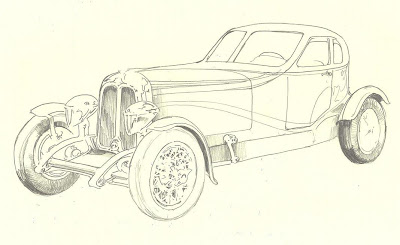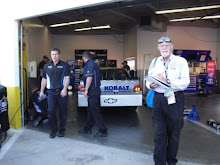Oil Tank Box Covers

The Oil Tank in a NASCAR race vehicle is located in a fabricated metal box behind the driver's seat, as indicated in this photo taken of a model Cup car.
NASCAR appears to want a "racertainment" series based on a cult of driver fame and corporate marketing, while trying to minimize the science and engineering development of the machine, i.e., the car. "Racertainment" is a word combining "racer" and "entertainment" coined by Peter DeLorenzo, author of the most excellent website
http://www.autoextremist.com/; it is highly recommended reading for anyone interested in all things about the automotive industry.
The latest NASCAR flap, oil tank box lids, typifies the result of trying to control ingenuity in a world where a better machine gathers up all of the rewards of the whole system. A faster car gets the driver to the front of the pack, more television coverage, and ultimate measure of success: more visibility for the sponsor. If there is any way to gain an advantage it will be pursued, relentlessly. Whether it is in better training and practice for pit crews, driver skills, or mechanical bits of the car itself, if there's an advantage to be gained, and the sponsor will foot the bill to pursue it, racers and engineers will work tirelessly to exploit whatever advantage is possible.
NASCAR race vehicles are strange anachronisms, the engine package used in the race cars today hasn't been used in a production car since the mid 1970's; the suspension system design largely dates back to the 1950's and the aerodynamic concept simply defies logic (any reasonably bright 12 year old could improve the under-car air flow, but improvements aren't allowed, it's the rules).

The underside of a NASCAR race vehicle is more than lumpy, it is an aerodynamic nightmare; if "aerodynamic" means making it smooth to minimize drag, the underside of a NASCAR Cup racer is a very un-aerodynamic mess.
You can approximate this by making a box with a lumpy bottom, including an indented (closed on top) pocket (the now infamous oil tank box) and holding your pretend racer out the window of your car while a friend drives along a highway.
Some considerable force is required to hold the box steady at speeds above 45 mph or so.
There's a high pressure area at the front of your wedge car, and also under the car. The pocket for the oil tank helps stall (low speed) the air under the car, creating a high pressure and diminishing the downforce on the race car.
These CFD diagrams are from the FloWorks component of SolidWorks, a software CAD program included in the FastTrack Racing Challenge kit; thanks to Marie Planchard and the SolidWorks company in supporting student design projects.

The air speed along the bottom of the car and in the Oil Tank Box is very low (this increases the local pressure, a result now commonly called the Bernoulli effect).
A simple modification, poking the indented pocket open so air can escape into the box representing the main car body, then cutting a hole in the back of your pretend racer, and surprise! it takes much less force to hold your racer steady as you're driven along the highway.
Air is vented from the high pressure area under the car to the low pressure area behind the car. This accomplishes two things, it increases the downforce on the car (giving it better traction in the corners) and secondly, it reduces the drag (air resistance) thus allowing the car to run faster with a given amount of power.
Poking the hole to open the indented cavity is the same as taking the lid off the box inside the race car which contains the oil tank.

Air is able to flow up through the Oil Tank Box into the main body of the car and out the back.
This has two effects: it reduces the drag (air resistance) of the vehicle, hence less power is required to push it through the air; and, secondly, it reduces the pressure under the car, thereby generating more downforce and improving the grip of the car on the track.
From the numbers generated here in FloWorks it sounds as if some of the numbers now circulating on various blogs and news stories about the improvement gained by the 99 car in having the lid to the Oil Tank Box "fall off" during racing are entirely credible. The 99 car may have realized as much as an additional 100 lbs of downforce (Cup cars generate about 700 lbs of downforce at race speeds), so perhaps as much as a 12% increase, with a similar reduction in drag, about 100 lbs. At the speeds of the cars in Las Vegas this would amount to a reduction of perhaps 40 hp needed to push the car, or conversely it would allow the car to run faster with the same hp.
As more than one driver has observed, very seldom do you see parts falling off of a race car where the loss of the part would diminish its performance. The loss of parts which enhance the performance of the race car is entirely a different matter.
Engineering science is now very good at analyzing parts and assemblies of parts to determine the conditions under which they will fail. Designing a couple of bolts to fail after some period of rather severe vibration (a race car going 185 mph) is not that difficult. In defense of Roush Racing the complete loss of the lid on the Oil Tank Box was most likely a real accident, it wasn't supposed to fall off entirely.
Because of the rules NASCAR has written to limit engineering creativity in large areas (changing the shape of the car, or the under-body), even more eningeering is now required to find an ever diminishing advantage in an ever smaller field of play; all of this requires still more technology and engineering dollars, not less.
Working on a race car that has hit the wall or another car during a race is an integral part of NASCAR racing.

As an engineer it would seem that one of the most fruitful areas of investigation with the new car would be to explore "creative failures:" parts of the car that can be modified under the guise of "repairs" or "fixing the car" after incidental contact with the wall or another car. The "repairs" are actually modifications, but done carefully to improve aerodynamics. Venting air from under the car is so beneficial that it's easy to suggest that this latest "lid flap" will be just the tip of the iceberg, the start of really inventive engineering: parts that bend and/or fail during racing, along with pit road "repairs," as very clever ways to improve vehicle performance.
Inspite of every effort by NASCAR to the contrary, the team with the best (and most inventive) eingeering staff will always be at the front.
Thanks for a lap around the track with me; I'll see you on the next pit stop.
 After 2012, the rate at which the price of oil is increasing is going to jump dramatically. There won't be any new fields to offset the depletion of the existing fields.
After 2012, the rate at which the price of oil is increasing is going to jump dramatically. There won't be any new fields to offset the depletion of the existing fields.































